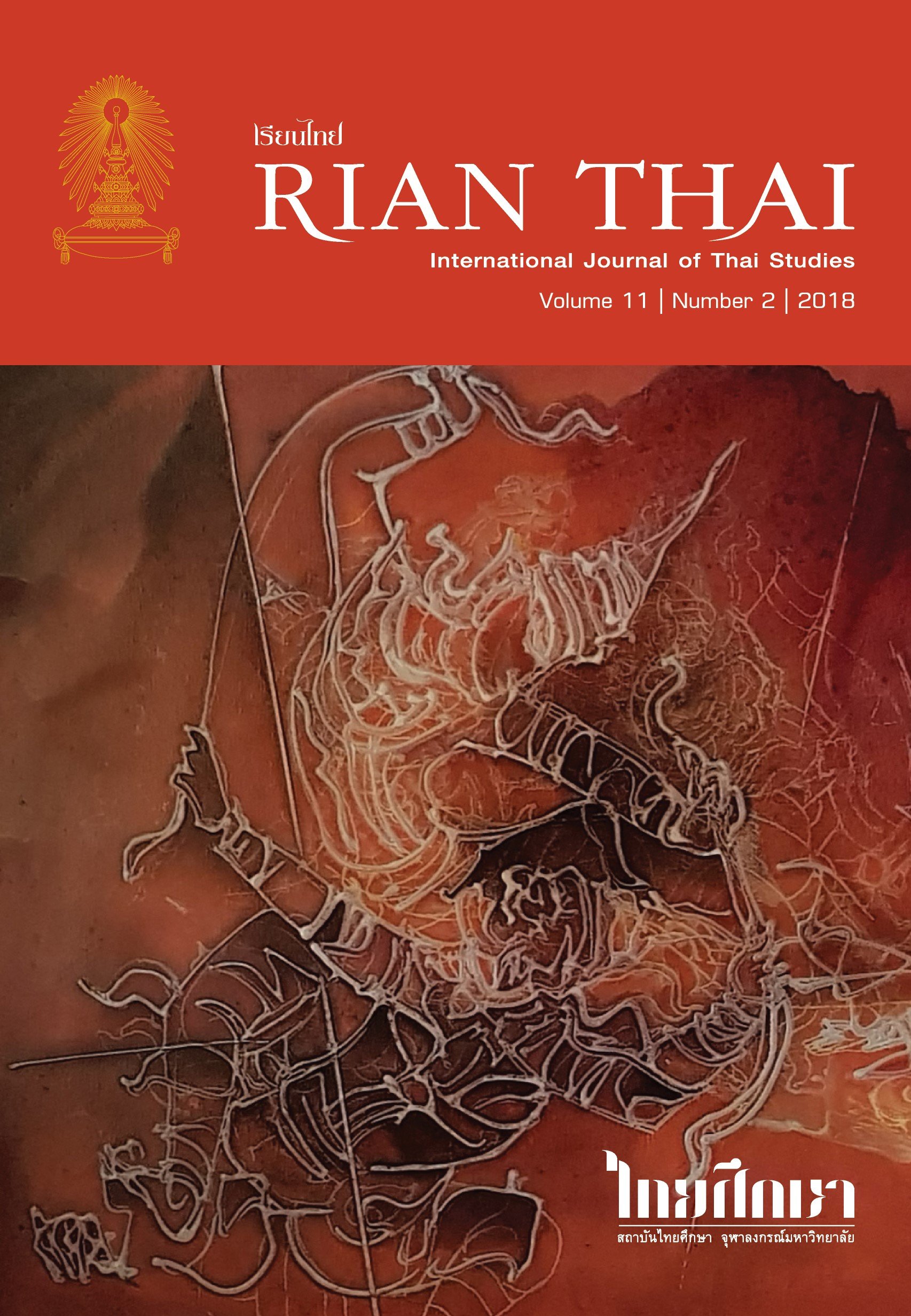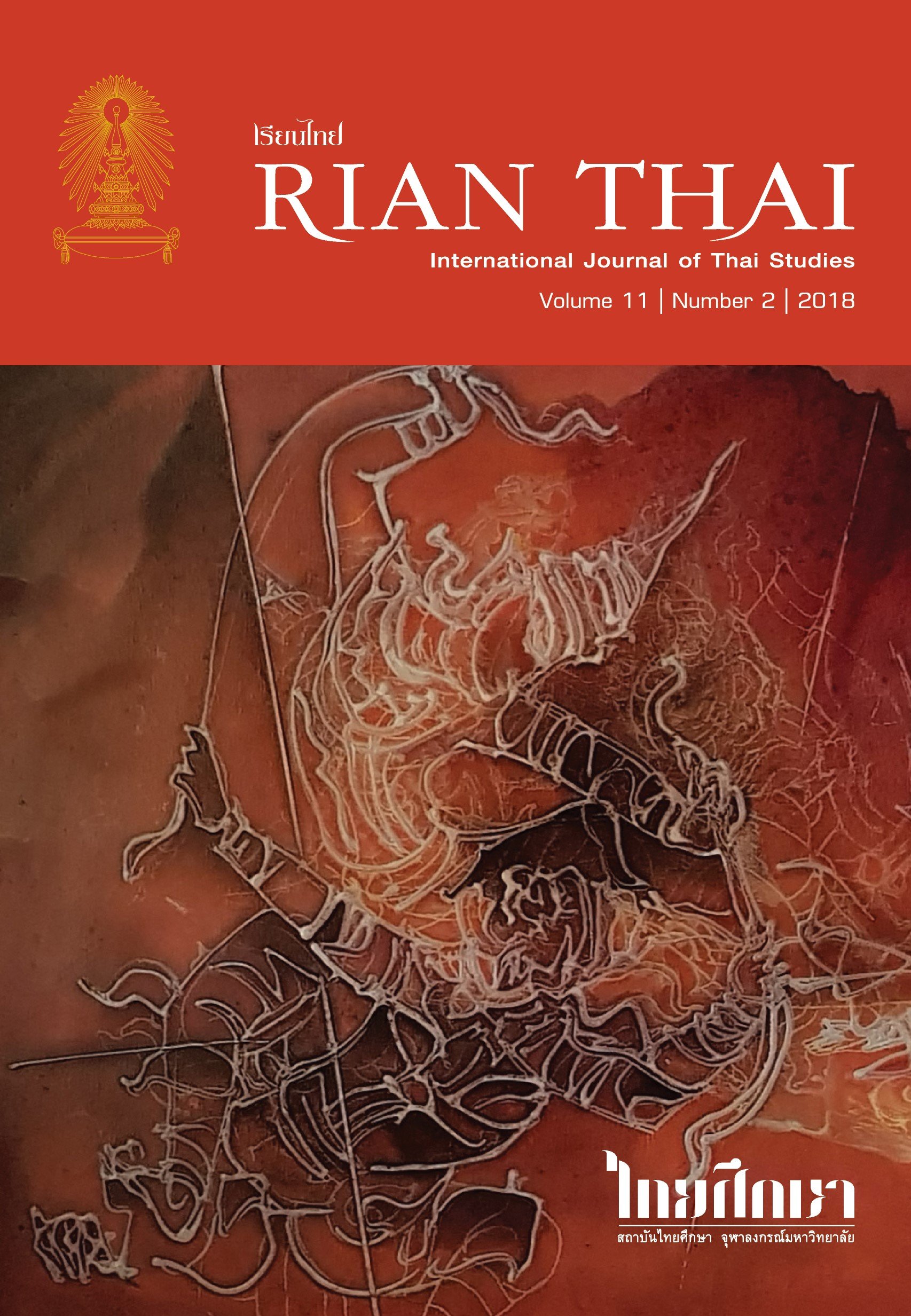Rian Thai - Volume 11/2018 (Number 2)

1) Interpersonal Relationships of Thai Classical Music Teaching and Learning in University Settings / Hei Ting Wong and Pornprapit Phoasavadi
2) Ventures of Business and Love – The Migration of Thai Women to Austria / Kosita Butratana
3) Cultural Heritage and Local Society: A Caseload Study from Phrae Province, Northern Thailand / Mizuho Ikeda
4) The Creation of a “Lanna Sense of Place” Through Fine Art in Northern Thailand: A Case Study of Hotel Lobby Decorations in Chiang Mai and Chiang Rai / Muhammad Faizal Bin Abdul Rani
5) Sustainable Development through Ecotourism: A Comparison between Nan City of Thailand and Hanno City of Japan / Rossawan Ponluksanapimol
6) The Spirits and Their Roles in Isan Folk Jatakas / Suddhinan Sri-on and Pathom Hongsuwan
Interpersonal Relationships of Thai Classical Music Teaching and Learning in University Settings
Hei Ting Wong and Pornprapit Phoasavadi
Abstract
Thai classical music has always been an essential part of Thai life. However, since the reign of King Mongkut—King Rama IV—Thai classical music has suffered from a decline in interest because of changes of ruling powers and foreign influence, which also brought changes to Thai society. After a century of blending and struggling between keeping Thai traditions and accepting Western influence, a movement unfolded in the 1970s to aid in the revival of Thai classical music. One of the achievements of the movement was the institutionalization of Thai classical music by establishing Thai music departments in researchbased universities in Thailand in the 1980s. The purpose of this project is to investigate the relationships between the personnel who are involved in the teaching and learning of Thai classical music in Thai higher education. This research focuses specifically on the traditional master-apprentice learning method of Thai classical music, the relationship between teachers and students, and among students, under institutionalization. Research data was collected through observing interactions between teacher and students, both inside and outside the classroom, and conducting interviews with masters/educators and students at Chulalongkorn University, with a pilot study at the Thai Music Ensemble at Kent State University, Ohio, the United States.
Keywords: Thai classical music teaching, the traditional master-apprentice learning method, relationship between teachers and students, the institutionalization of Thai classical music teaching
(Published in Rian Thai: International Journal of Thai Studies, Volume 11/2018 (Number 2), Page 1-28)
Ventures of Business and Love – The Migration of Thai Women to Austria
Kosita Butratana
Abstract
Thai people account for the second largest group from migrants from Southeast Asia in Austria and represent a highly gendered migrant group since 84% of them are female. This paper outlines four flows of Thai outbound migration and introduces the sociodemographic context of Thai migrants in Austria. The literature review draws on cultural concepts such as individualism and collectivism, concepts of social and transnational relations, the notion of paradoxical hypergamy and geographies of emotion and love. Based on semi-structured interviews with Thai marriage migrants, this research further explores the aspirations, experiences and transnational relations of Thai marriage migrants in Austria. Three cases of migrants were selected from different geographical migrant source and target regions, various migration channels and distinct experiences in order to show the migrant’s diverse backgrounds and perspectives in a transnational context.
Keywords: Thai migrants in Austria, Thai migration to Austria, transnational marriages, marriage-related migration, migration and cross-cultural relationships
(Published in Rian Thai: International Journal of Thai Studies, Volume 11/2018 (Number 2), Page 29-56)
Cultural Heritage and Local Society: A Caseload Study from Phrae Province, Northern Thailand
Mizuho Ikeda
Abstract
This article discusses cultural heritage from the viewpoint of local society. In doing so, the article presents a concept that is different from that created by the nationstate, or the heritage protection framework led by national governments. In Thailand, from the premodern period to the present, there has been an inherent value and a unique relationship between “cultural heritage” and the people, which has contributed to forming a unique worldview as part of people’s life. As a matter of course, these practitioners have been neither the ruling class of royalty and bureaucrats, nor the intelligentsia, but the general people – the “successor of local history” (Haga 329). Local heritage in Thailand has been an ntegral part of people’s lives and is interrelated with animistic beliefs and Theravada Buddhism, of which more than 90% of the population in Thailand follows, and therefore, continues to play an important role as people’s foothold in an increasingly fluid society.
In order to understand the relationship between cultural heritage and local communities, two questions are raised. Firstly, what does cultural heritage mean for people within their own communities, and what kind of connections can be identified? Secondly, is there any independent movement of local communities based on interpretations that differ from the central government? In accordance with the issues, the article begins by summarizing the historical and cultural features of northern Thailand and then moves to examine a case study from Phrae province.
Keywords: local heritage in Thailand, historical and cultural features of northern Thailand, relationships between cultural heritage and local communities, conservation of cultural heritage
(Published in Rian Thai: International Journal of Thai Studies, Volume 11/2018 (Number 2), Page 57-75)
The Creation of a “Lanna Sense of Place” Through Fine Art in Northern Thailand: A Case Study of Hotel Lobby Decorations in Chiang Mai and Chiang Rai
Muhammad Faizal Bin Abdul Rani
Abstract
Thailand has struggled to maintain a balance between fast development and traditional values in the modern context. The northern region of Thailand is no exception and was used as a case study in assessing how local culture and belief can survive in the modern world. The Revival Period of Lanna, late-18th to 21st century, during the reign of Chao Kawila (1782-1813) up to the present, was chosen to be evaluated in this research. The scope was five-star hotels in Chiang Mai and Chiang Rai.
From this research, it was found that people are more attracted to the aesthetic value of the selected fine art. These fine art objects – furniture, sculpture, flower, painting, wood carving panel, human object, animal object and accessories – are the favourite items to be applied by the hotels. Such fine art tends to more function as decorative items as compared to previous practice where such items were applied to the main building structure. From the finding, it can be concluded that any trend or practice can be observed and any weaknesses can be improved in order to deliver accurate information about local style.
Keywords: a case study of hotel lobby decorations, Thai hotel decorations, the creation of sense of place, Lanna, hotel lobby decorations in Chiang Mai and Chiang Rai
(Published in Rian Thai: International Journal of Thai Studies, Volume 11/2018 (Number 2), Page 77-95)
Sustainable Development through Ecotourism: A Comparison between Nan City of Thailand and Hanno City of Japan
Rossawan Ponluksanapimol
Abstract
Thailand is considered one of the world’s most popular tourist destinations. Amid the rise of middle income population and advanced aviation technology, Thailand receives a significant number of tourists every year. The country needs to find a sustainable way to manage its tourism resources to prevent its resources from being harmed. This brings in the concept of sustainable tourism, of which a popular and fast growing form is ecotourism. Thailand introduced a sustainable tourism policy in 2008 called the “Seven Greens” concept. However, the Seven Greens concept leans heavily towards environmental aspects and not so much on the culture and the people. On the other hand, Hanno City, designated by the ministry of environment of Japan as a model city for the management of tourism based on nature, community and culture, realizes the importance of all three. The city promotes creative tourism, human capabilities, and community participation as its solution to social well-being in the society and sustainability in its ecotourism industry.
This article compares the situation in Nan City with that of Hanno City in Japan and suggests how tourism in Nan City can be more sustainable through active community participation and creative tourism promotion.
Keywords: sustainable tourism, ecotourism in Thailand and Japan, Nan City, Hanno City, community participation in the management of ecotourism, Seven Greens concept
(Published in Rian Thai: International Journal of Thai Studies, Volume 11/2018 (Number 2), Page 97-115)
The Spirits and Their Roles in Isan Folk Jatakas
Suddhinan Sri-on and Pathom Hongsuwan
Abstract
This study aimed at investigating the beliefs and roles of the spirit characters in eight Isan folk jatakas: Kamphra Phi Noi, Katchanarm, Thawgam Gadam, Nang Tang-on, Phaya Khankhak, Lin Thong, Suriwong and Hong Hin. In these Jatakas, the beliefs in and roles of spirits are prominent.
The findings show that spirits in Isan folk jatakas are relevant to the Bodhisattva in two ways: 1) the spirits are the rivals of the Bodhisattva; they do not believe in the Bodhisattva, nor do they have good intention for the Bodhisattva, doing bad deeds, thus making the Bodhisattva preach to them about karma and the dharma; and 2) the spirits believe in and follow the Bodhisattva’s teachings and support the Bodhisattva to succeed in something.
Thus, the roles of the spirit characters in Isan folk jatakas support dharma teaching, making the readers see that good conquers evil and helps understand the concept of karma in Buddhism. The roles, in addition, reflect the belief system of the Isan people in the Buddhist culture. Accordingly, beliefs in spirits and Buddhism can co-exist, being a part of each other.
Keywords: Thai Isan folk jatakas, beliefs and roles of the spirit characters, beliefs in spirits and Buddhism, good and evil spirits in Isan folk jatakas
(Published in Rian Thai: International Journal of Thai Studies, Volume 11/2018 (Number 2), Page 117-140)
